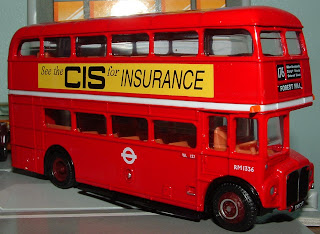
A blog focusing on 1/64 diecast from such popular brands as Hot Wheels, Matchbox, Johnny Lightning, M2 Machines, GreenLight, Tomica, Yat Ming, Majorette, MotorMax, Siku, Corgi, Guisval, Playart, Ertl, Zylmex, Racing Champions, & many more. Swifty's Garage features a daily Car Of The Day and news updates from your favorite brands!
Friday, May 4, 2012
Bus Of The Day: May 4, 2012
Today's car of the day is EFE's 1959 AEC Routemaster.
The AEC Routemaster is a double-decker bus built by Associated Equipment Company (AEC) in 1954 (in production from 1958) until 1968. Front-engined buses generally with rear platforms, a small number were produced with doors and/or front entrances. Introduced by London Transport in 1956, the Routemaster saw continuous service in London until 2005, and remains on two heritage routes in central London.
The Routemaster was developed by AEC in partnership with London Transport, the customer for nearly all new Routemasters, although small numbers were also delivered to the airline British European Airways (BEA) and the Northern General Transport Company. 2,876 Routemasters were built, with approximately 1,000 still in existence.
A pioneering design, the Routemaster outlasted several of its replacement types in London, survived the privatisation of the former London Transport bus operators and was used by other operators around the UK. In modern UK public transport bus operation, the old-fashioned features of the standard Routemaster were both praised and criticised. The open platform, while exposed to the elements, allowed boarding and alighting away from stops; and the presence of a conductor allowed minimal boarding time and optimal security, but with greater labour costs.
The Routemaster became one of London's most famous symbols, with much tourist paraphernalia continuing to bear Routemaster imagery, and with examples still in existence around the world. Despite its fame, the earlier and more numerous London bus classes that the Routemaster replaced (the RT-type AEC Regent and its Leyland Titan RTL and RTW counterparts) are often mistaken for Routemasters by the public and by the media.
Despite the retirement of the original version, the Routemaster has retained iconic status, and in the late 2000s work began on an updated version, which entered service in February 2012.
For more information and pictures of the real car please visit: AEC Routemaster
This was acquired from bangerkid45 (thanks Jon!) at the Keystone CARnival this year.
The Routemaster bus was developed in 1947–1956 by a team directed by A. A. M. Durrant and Colin Curtis, with vehicle styling by Douglas Scott. The design brief was to produce a vehicle that was lighter (hence more fuel efficient) and easier to operate and that could be maintained by the existing maintenance practices at the recently-opened Aldenham Works. The resulting vehicle seated 64 passengers despite being three-quarters of a ton lighter than the RT family, which seated 56. The first task on delivery to service was to replace London's trolleybuses, which had themselves replaced trams, and to begin to replace the older types of diesel bus. The Routemaster was intended for London use, being designed by London Transport and constructed at the AEC Works in Southall, Middlesex, with assembly at bodybuilder Park Royal Vehicles, a subsidiary company of AEC.
It was an innovative design and used lightweight aluminium and techniques developed in aircraft production during World War II. As well as a novel weight-saving integral design, the Routemaster also introduced for the first time on a bus independent front suspension, power steering, a fully automatic gearbox and power-hydraulic braking. This surprised some early drivers, who found the chassis unexpectedly light and nimble compared with older designs, especially as depicted on film on tests at the Chiswick Works "skid pan". Footage of RM200 undergoing the skid test at Chiswick was included in the 1971 film On the Buses.
The Routemaster was a departure from the traditional chassis/body construction method. It was one of the first "integral" buses, with a combination of an "A" steel sub-frame (including engine, steering and front suspension) and a rear "B" steel sub-frame (carrying rear axle and suspension), connected by the aluminium body. The gearbox was mounted on the underside of the body structure with shafts to the engine and back axle.
Subscribe to:
Post Comments (Atom)






No comments:
Post a Comment